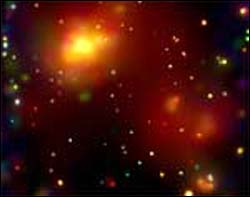Chandra catches early phase of cosmic assembly

Chandra image reveals intergalactic hot gas clouds (NASA/UMass/D. Wang et al.)
A NASA Chandra X-ray Observatory image has revealed a complex of several intergalactic hot gas clouds in the process of merging. The superb Chandra spatial resolution made it possible to distinguish individual galaxies from the massive clouds of hot gas. One of the clouds, which envelopes hundreds of galaxies, has an extraordinarily low concentration of iron atoms, indicating that it is in the very early stages of cluster evolution.
“We may be seeing hot intergalactic gas in a relatively pristine state before it has been polluted by gas from galaxies,” said Q. Daniel Wang of the University of Massachusetts in Amherst, and lead author on an upcoming Astrophysical Journal article describing the study. “This discovery should provide valuable insight into how the most massive structures in the universe are assembled.”
The complex, known as Abell 2125, is about 3 billion light years from Earth and is seen at a time about 11 billion years after the Big Bang. This is a period when astronomers believe many galaxy clusters are formed. Chandra’s Abell 2125 image shows several huge elongated clouds of multimillion-degree-gas coming together from different directions. These hot gas clouds, each of which contains hundreds of galaxies, appear to be in the process of merging to form a single massive galaxy cluster.
Chandra, Hubble Space Telescope, and Very Large Array radio telescope data show that several galaxies in the Abell 2125 core cluster are being stripped of their gas as they fall through surrounding high-pressure hot gas. This stripping process has enriched the core cluster’s gas in heavy elements such as iron.
The gas in the pristine cloud, which is still several million light years away from the core cluster, is conspicuous for its lack of iron atoms. This anemic cloud must be in a very early evolutionary stage. The iron atoms produced by supernovas in the embedded galaxies must still be contained in and around the galaxies, perhaps in grains of dust not well mixed with the observed X-ray-emitting gas. Over time, as the cluster merges with the other clusters and the hot gas pressure increases, the dust grains will be driven from the galaxies, mixed with the hot gas, and destroyed, liberating the iron atoms.
Building a massive galaxy cluster is a step-by-step enterprise that takes billions of years. Exactly how long it takes for such a cluster to form depends on many factors, such as the density of subclusters in the vicinity, the rate of the expansion of the universe, and the relative amounts of dark energy and dark matter.
Cluster formation also involves complex interactions between the galaxies and the hot gas that may determine how large the galaxies in the cluster can ultimately become. These interactions determine how the galaxies maintain their gas content, the fuel for star formation. The observations of Abell 2125 provide a rare glimpse into the early steps in this process.
Frazer Owen (National Radio Astronomy Observatory) and Michael Ledlow (Gemini Observatory) are co-authors on the upcoming Astrophysical Journal paper. Chandra observed Abell 2125 with its Advanced CCD Imaging Spectrometer on August 24, 2001, for approximately 22 hours.
NASA’s Marshall Space Flight Center, Huntsville, Ala., manages the Chandra program for NASA’s Office of Space Science, Washington. Northrop Grumman of Redondo Beach, Calif., formerly TRW, Inc., was the prime development contractor for the observatory. The Smithsonian Astrophysical Observatory controls science and flight operations from the Chandra X-ray Center in Cambridge, Mass.
Media Contact
All latest news from the category: Physics and Astronomy
This area deals with the fundamental laws and building blocks of nature and how they interact, the properties and the behavior of matter, and research into space and time and their structures.
innovations-report provides in-depth reports and articles on subjects such as astrophysics, laser technologies, nuclear, quantum, particle and solid-state physics, nanotechnologies, planetary research and findings (Mars, Venus) and developments related to the Hubble Telescope.
Newest articles

Innovative 3D printed scaffolds offer new hope for bone healing
Researchers at the Institute for Bioengineering of Catalonia have developed novel 3D printed PLA-CaP scaffolds that promote blood vessel formation, ensuring better healing and regeneration of bone tissue. Bone is…

The surprising role of gut infection in Alzheimer’s disease
ASU- and Banner Alzheimer’s Institute-led study implicates link between a common virus and the disease, which travels from the gut to the brain and may be a target for antiviral…

Molecular gardening: New enzymes discovered for protein modification pruning
How deubiquitinases USP53 and USP54 cleave long polyubiquitin chains and how the former is linked to liver disease in children. Deubiquitinases (DUBs) are enzymes used by cells to trim protein…


